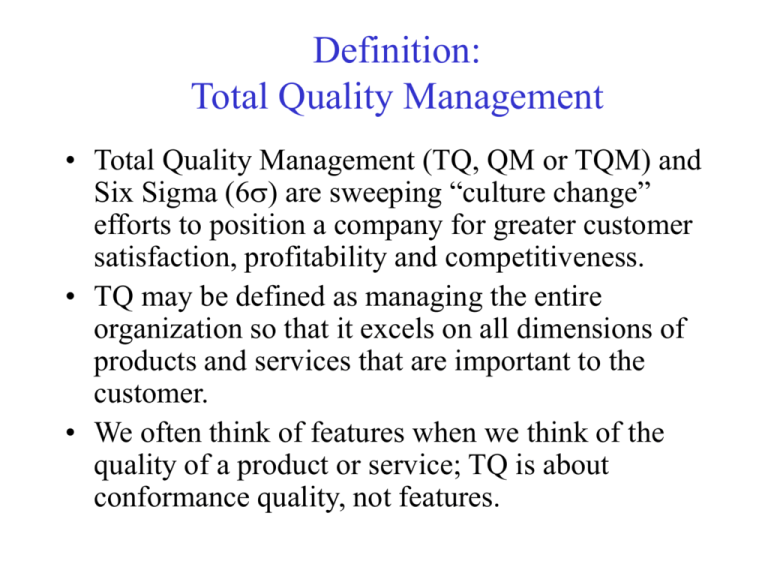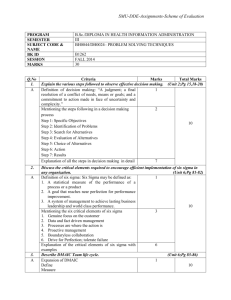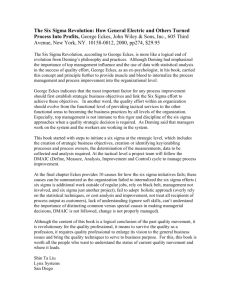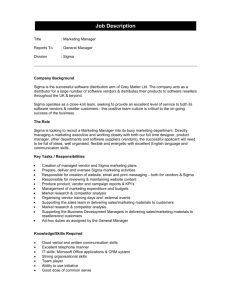Definition: Total Quality Management
advertisement

Definition: Total Quality Management • Total Quality Management (TQ, QM or TQM) and Six Sigma (6) are sweeping “culture change” efforts to position a company for greater customer satisfaction, profitability and competitiveness. • TQ may be defined as managing the entire organization so that it excels on all dimensions of products and services that are important to the customer. • We often think of features when we think of the quality of a product or service; TQ is about conformance quality, not features. Total Quality Is… • Meeting Our Customer’s Requirements • Doing Things Right the First Time; Freedom from Failure (Defects) • Consistency (Reduction in Variation) • Continuous Improvement • Quality in Everything We Do A Quality Management System Is… • A belief in the employee’s ability to solve problems • A belief that people doing the work are best able to improve it • A belief that everyone is responsible for quality Elements for Success • • • • • • • • • Management Support Mission Statement Proper Planning Customer and Bottom Line Focus Measurement Empowerment Teamwork/Effective Meetings Continuous Process Improvement Dedicated Resources The Continuous Improvement Process Empowerment/ Shared Leadership Customer Satisfaction Business Results Team Management Process Improvement/ Problem Solving Measurement Measurement Measurement ... Measurement Modern History of Quality Management • Frederick W. Taylor wrote Principles of Scientific Management in 1911. • Walter A. Shewhart used statistics in quality control and inspection, and showed that productivity improves when variation is reduced (1924); wrote Economic Control of Manufactured Product in 1931. • W. Edwards Deming and Joseph M. Juran, students of Shewhart, went to Japan in 1950; began transformation from “shoddy” to “world class” goods. • In 1960, Dr. K. Ishikawa formalized “quality circles” - the use of small groups to eliminate variation and improve processes. • In the late ‘70’s and early ‘80’s: – Deming returned from Japan to write Out of the Crisis, and began his famous 4-day seminars in the United States – Phil Crosby wrote Quality is Free – NBC ran “If Japan can do it, why can’t we?” – Motorola began 6 Sigma History of Quality Management Deming’s 14 Points 1. Create constancy of purpose for improvement 2. Adopt a new philosophy 3. Cease dependence on mass inspection 4. Do not award business on price alone 5. Work continually on the system of production and service 6. Institute modern methods of training 7. Institute modern methods of supervision of workers 8. Drive out fear 9. Break down barriers between departments 10. Eliminate slogans, exhortations, and targets for the work force 11. Eliminate numerical quotas 12. Remove barriers preventing pride of workmanship 13. Institute a vigorous program of education and retraining 14. Take action to accomplish the transformation History of Quality Management Deming’s Concept of “Profound Knowledge” Understanding (and appreciation) of Systems - optimizing sub-systems sub-optimizes the total system - the majority of defects come from systems, the responsibility of management (e.g., machines not in good order, defective material, etc. Knowledge of Statistics (variation, capability, uncertainty in data, etc.) - to identify where problems are, and point managers and workers toward solutions Knowledge of Psychology (Motivation) - people are afraid of failing and not being recognized, so they fear how data will be used against them Theory of Knowledge - understanding that management in any form is a prediction, and is based on assumptions History of Total Quality According to Dr. Joseph M. Juran (1991): “On the assembly line at the Ford Motor Company in 1923, most of the workers producing Model T’s were immigrants and could not speak English. Many were also illiterate. Workers learned their trade by modeling the actions of other workers. They were unable to plan, problem-solve, and make decisions. As a result, the Taylor scientific school of management flourished, and MBAs and industrial engineers were invented to do this work. Today, however, the workforce is educated. Workers know what is needed to improve their jobs, and companies that do not tap into this significant source of knowledge will truly be at a competitive disadvantage.” History of Total Quality According to Phil Crosby, Quality is . . . An attitude: - Zero Defects - Continuous Improvement A measurement: - Price of Conformance, plus - Price of Nonconformance (defects) TQ: Transforming an Organization From To Motivation through fear and loyalty Motivation through shared vision Attitude: “It’s their problem” Ownership of every problem affecting the customer Attitude: “the way we’ve always done it” Continuous improvement Decisions based on assumptions/ judgment calls Decisions based on data and facts Everything begins and ends with management Everything begins and ends with customers Crisis management and recovery Doing it right the first time Choosing participative OR scientific management Choosing scientific AND participative management What is Six Sigma? • A goal of near perfection in meeting customer requirements • A sweeping culture change effort to position a company for greater customer satisfaction, profitability and competitiveness • A comprehensive and flexible system for achieving, sustaining and maximizing business success; uniquely driven by close understanding of customer needs, disciplined use of facts, data, and statistical analysis, and diligent attention to managing, improving and reinventing business processes (Source:The Six Sigma Way by Pande, Neuman and Cavanagh) Is 99% Quality Good Enough? • 22,000 checks will be deducted from the wrong bank accounts in the next 60 minutes. • 20,000 incorrect drug prescriptions will be written in the next 12 months. • 12 babies will be given to the wrong parents each day. Six Sigma Quality The objective of Six Sigma quality is 3.4 defects per million opportunities! (Number of Standard Deviations) 3 Sigma 4 Sigma 5 Sigma 6 Sigma 0.0 2700 63 0.57 0.002 0.5 6440 236 3.4 0.019 1.0 22832 1350 32 0.019 1.5 66803 6200 233 3.4 2.0 158,700 22800 1300 32 Defects Per Million Opportunities (DPMO) · 100K But is Six Sigma Realistic? · IRS – Tax Advice (phone-in) (66810 ppm) 10K 41 Average Company 1K 31 ···· ··· Restaurant Bills Doctor Prescription Writing Payroll Processing Order Write-up Journal Vouchers Wire Transfers Air Line Baggage Handling Purchased Material Lot Reject Rate 100 21 · (233 ppm) 10 11 Best in Class 1 1 Domestic Airline Flight Fatality Rate (3.4 ppm) 2 3 3 4 4 SIGMA 5 5 6 6 7 (0.43 ppm) 7 Six Sigma Improvement Methods DMAIC vs. DMADV Define Measure Analyze Continuous Improvement Reengineering Improve Design Control Validate Six Sigma DMAIC Process Control Improve Define Analyze Measure Define: Define who your customers are, and what their requirements are for your products and services – Their expectations. Define your team goals, project boundaries, what you will focus on and what you won’t. Define the process you are striving to improve by mapping the process. Six Sigma DMAIC Process Control Improve Define Analyze Measure Measure: Eliminate guesswork and assumptions about what customers need and expect and how well processes are working. Collect data from many sources to determine speed in responding to customer requests, defect types and how frequently they occur, client feedback on how processes fit their needs, how clients rate us over time, etc. The data collection may suggest Charter revision. Six Sigma DMAIC Process Control Improve Define Analyze Measure Analyze: Grounded in the context of the customer and competitive environment, analyze is used to organize data and look for process problems and opportunities. This step helps to identify gaps between current and goal performance, prioritize opportunities to improve, identify sources of variation and root causes of problems in the process. Six Sigma DMAIC Process Control Improve Define Analyze Measure Improve: Generate both obvious and creative solutions to fix and prevent problems. Finding creative solutions by correcting root causes requires innovation, technology and discipline. Six Sigma DMAIC Process Control Improve Define Analyze Measure Control: Insure that the process improvements, once implemented, will “hold the gains” rather than revert to the same problems again. Various control tools such as statistical process control can be used. Other tools such as procedure documentation helps institutionalize the improvement. Six Sigma DMADV Process Validate Design Define Analyze Measure Design: Develop detailed design for new process. Determine and evaluate enabling elements. Create control and testing plan for new design. Use tools such as simulation, benchmarking, DOE, Quality Function Deployment (QFD), FMECA analysis, and cost/benefit analysis. Six Sigma DMADV Process Validate Design Define Analyze Measure Validate: Test detailed design with a pilot implementation. If successful, develop and execute a full-scale implementation. Tools in this step include: planning tools, flowcharts/other process management techniques, and work documentation.





